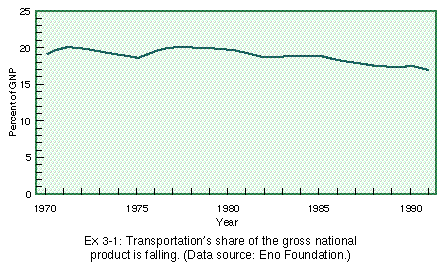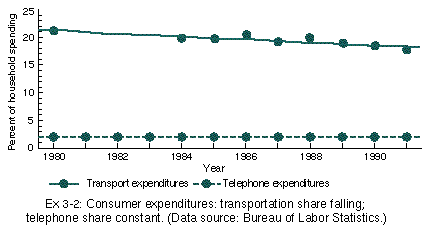
![]()
One important factor in the continuing strength of surface travel demand in the face of telecommunications alternatives is that the cost of driving that is paid directly by users is actually declining. This is partly because of the increasing energy efficiency of automobiles and partly because of a reduction in the real cost of fuel since 1980. From 1978 to 1991, transportation outlays decreased from 20.2% to 16.9% of the gross national product, as shown in Exhibit 3-1.

![]()
The increasing energy efficiency of travel, with a consequential reduction in this portion of travel costs, is one reason why transportation continues to be attractive as an economic input. In comparing consumer expenditures for transportation and telecommunications in Exhibit 3-2, two observations stand out. First, transportation spending is much higher than telecommunications spending, which also includes home computer purchases. Second, the share of transportation spending is actually falling.
Transportation seems less expensive than it really is, because a substantial portion of the costs are indirect and not felt by vehicle drivers and owners. Costs of automotive transportation are not fully covered by the "user fees" of fuel taxes, vehicle taxes, and tolls and require "subsidies" from local property taxes, general funds, and other indirect revenue sources. These costs include expenditures for roadway construction and maintenance, highway services, and parking. In 1991, about 40% of the $78 billion spent by federal, state and local government on highway capital and operating costs came from sources other than highway user fees (FHWA, 1991, p. 42).
Costs of parking are also mostly paid indirectly. An estimated 90% of all commuters park at no cost in employer-supplied parking. Much of the retail and other commercial business parking outside central business districts is also free. Parking, of course, involves significant costs: land, development, maintenance, and administration. The average annual cost of an off-street parking space has been estimated as $1000 (Shoup, 1990).

![]()
Riders of public transit also do not feel direct costs of transportation, since most transit systems, to meet operating costs, rely heavily on state and local tax sources or fund transfers to supplement fare box revenues. In 1991, state and local assistance accounted for more than 52% of transit operating costs (APTA, 1992 ).
This socializing of the cost of surface mobility means that transportation users experience a lower cost than would otherwise be borne. This then becomes one of the many economic forces that determine when and how much people drive and whether they make the effort to carry passengers. Even though telecommuting provides an alternative to commuting, the fact that driving is becoming less expensive in terms of direct out-of-pocket costs paid by drivers reduces the incentive for commuters to try telecommuting.
As long as transportation remains as inexpensive and functional as it is, the potential for telecommunications to displace surface transportation is limited. Coping with transportation disruptions caused by disasters and events is the exception to this conclusion. Unless public policies or other causes raise the perceived, directly-felt cost of travel, there is unlikely to be a slackening in the per-capita demand for travel, even as telecommunications applications diffuse more widely and more opportunities to avoid travel emerge. This conclusion comes straight from utility experience. When electricity is inexpensive, or does not increase in price at times when supplies are low, people use more of it. In many urban areas, in peak-demand periods, transportation is underpriced for users, and demand exceeds capacity. When prices are too low, demand for a desirable good rises to meet the supply. In the case of driving, congestion is the only cost to drivers that limits the "supply" and functionality of transportation.
Some drivers perceive rising traffic congestion as a growing cost of driving. There is much objective evidence that traffic congestion is becoming worse (Downs, 1992); however, the proportion of drivers who actually experience congestion on a regular basis has not been measured. Of drivers who do experience it, the evidence is lacking that a major proportion perceive congestion as a large enough cost to motivate behavior changes.
![]()
Go to:
![]()